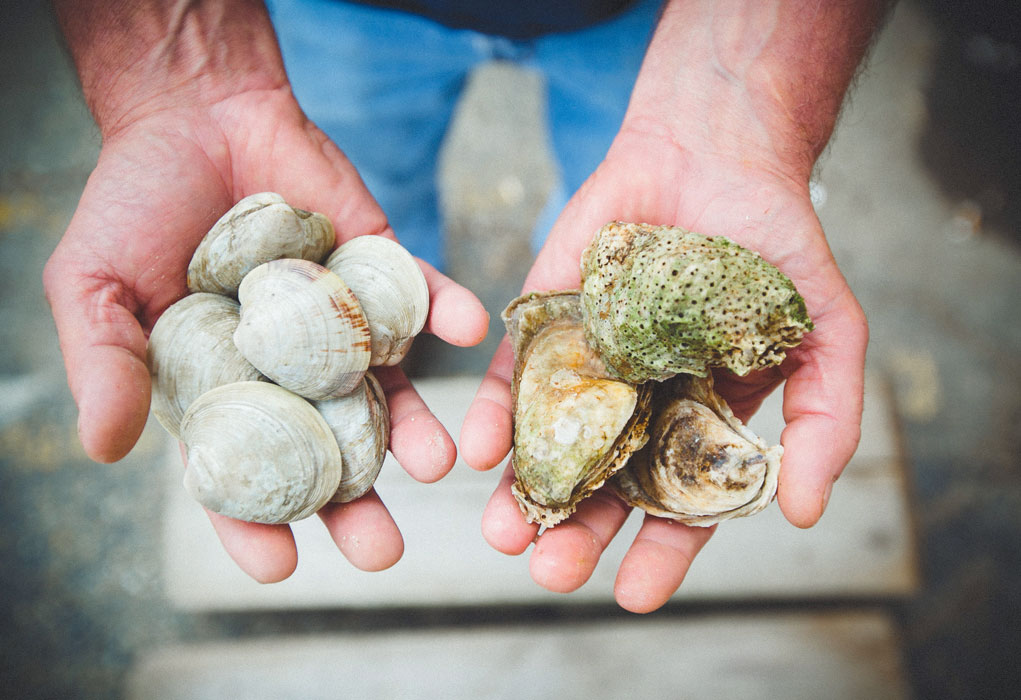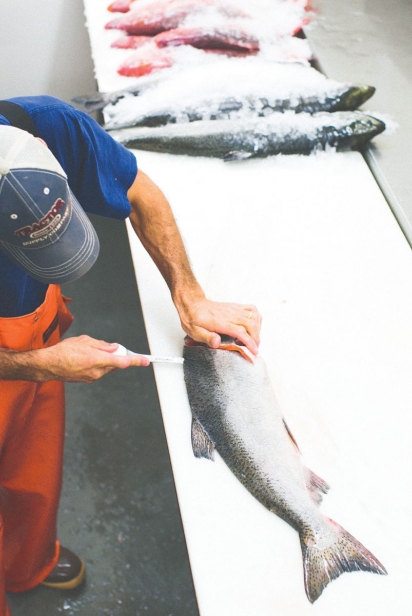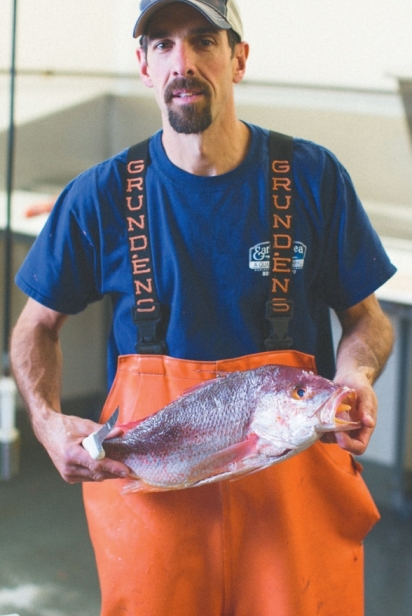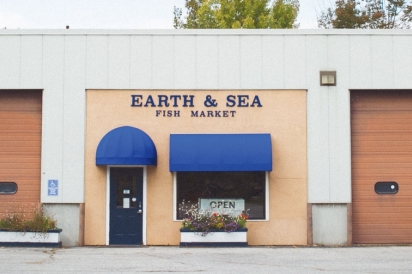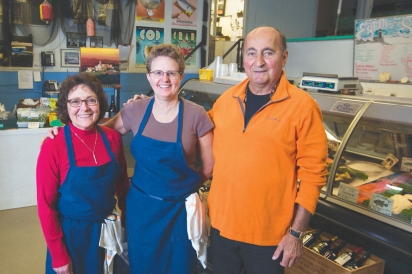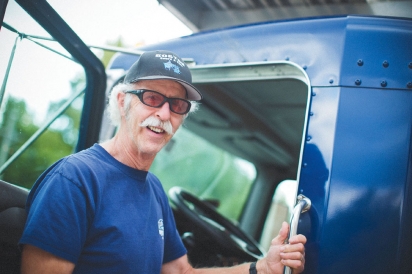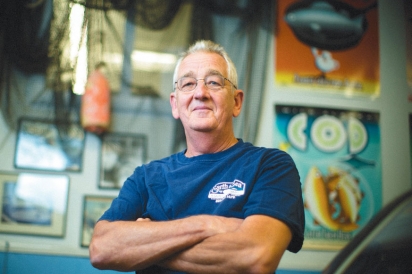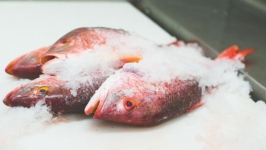From Dock to Mountain: 28 Years with Earth and Sea Fish Market
Greg Bishop pulled a shimmering fish from the crushed ice. With one hand grasping the tail and the other supporting the head, he lowered his nose into the stomach cavity, inhaled deeply and then inspected the sockeye’s dense flesh, firm eyes and glistening body.
“Nice and fresh. We’ll take the lot.”
With that confirmation, 500 pounds of wild Alaskan salmon were transferred from the Boston Fish Pier into Earth and Sea’s refrigerated truck, and Greg headed to the next warehouse to assess swordfish and halibut. Back in Vermont a few hours later, Steve Platts transformed the sockeye into long fillets, swordfish into broad half-moons and halibut into thick steaks. Lucky diners would soon feast on the freshest seafood available in the Green Mountains.
Clarity, color, consistency. Check the eyes, skin, belly and tail cut. Greg has worked with fish since he was 19 on the docks of Falmouth, Massachusetts, and he knows his trade.
“He’s the eyes and nose of our business,” said Bob Yakaitis, owner of Earth and Sea Fish Market in Manchester, Vermont. “Greg makes the final call on what fish come home to Vermont and what stays at the pier, and Steve is the best cutter in the business.” Earth and Sea procures only A+ graded seafood, and purveyors throughout the Boston market have met Bob’s demands for the past 28 years.
During a recent interview, Bob pointed to a faded snapshot of a greenhouse filled with ripe August tomatoes … standing in water six feet deep. “That was a 100-year flood of the Connecticut River in 1984. It drove me out of farming and into seafood.”
Bob had been growing field crops in central Connecticut, a business he took over from his dad. After that devastating flood, Bob moved north to Vermont and started selling seafood. Within a year, he was making the trek to Boston and sourcing his seafood direct at the fish piers located on the historic waterfront. Business took off and in 1986 he opened a retail market in Manchester.
Today, wholesale accounts for 85% of Earth and Sea’s business, Vermont’s oldest premier seafood resource. In 1999, the company moved to a larger facility a mile away for increased space and loading docks. Bob now employs 12 people, including four “road guys” who make the Boston trip and subsequent deliveries. Long-term employees include Rachel Bowlen, who manages the office while Joe Voto (the unofficial “mayor” of Manchester) and Wendy Lendway handle the retail customers out front.
Cod, oysters, blues, stripers, flounder, arctic char, monkfish, wild salmon, swordfish, squid, scallops, lobsters, halibut. That haul traveled from Boston to Manchester one afternoon last July. A typical week goes like this: On Saturday, Bob calls captains of Atlantic fishing boats and vendors in Boston to see what will be available. On Mondays and Wednesdays, plus Thursdays in the summer months, he sends a refrigerated truck to Boston to pick up the seafood. It’s a grueling 12- to 14-hour round trip that necessitates stops at 20–25 vendors throughout the fish pier. If the product is ready and passes muster, the driver can complete his rounds in three or four hours.
“Going there is fine because of the anticipation, but coming home is a different story,” said Bob, no stranger to the Boston route. The truck leaves before 5am and returns loaded with seafood by late afternoon.
“We buy fish whole so we can cut it into fillets and steaks ourselves. The longer the fish stays on the bone, the fresher it remains,” Bob explained. Once the truck returns, the cutters and packers work through the night to prepare the fish for shipping out first thing in the morning. Within 12 hours of arriving at Earth and Sea, that same seafood has been processed, repacked and is en route to more than 30 top restaurants and markets throughout Vermont, western New Hampshire and eastern New York.
What changes has Bob seen in nearly three decades?
“The 1980s and ’90s were boom years for seafood. Unfortunately, that led to overfishing and severe depletions of cod, haddock, flounder, halibut and striped bass. Thanks to stricter regulations and management policies, those groundfish are now recovering. Imported farmed salmon became popular in the ’80s. People started to see it regularly in the supermarket, developed a taste for it and liked the price. Salmon is still the top seller for restaurants.”
America’s love affair with seafood began in the 1970s with shrimp, the gateway drug for future pescophiles: fat pink curlicues swabbed through a sweet red cocktail sauce, or slicked with olive oil, garlic and herbs. Then came batter-fried popcorn style. Shrimp remains the most popular seafood on the planet, even surpassing canned tuna.
Can we love seafood too much? What makes for sustainable seafood?
According to the Marine Stewardship Council, a species is sustainable if it is not overfished; if the catch methods do not jeopardize vulnerable species such as dolphins or sea turtles or cause permanent damage to the seabed; and if bycatch and discards are avoided as much as possible. Fishermen have to abide by strict federal laws established by the National Ocean and Atmosphere Association. NOAA determines when a fishing ground should be closed to protect the stock and sets catch limits. For example, swordfish boats have a federal agent on board who monitors the catch over the season. Some fishermen may not like the quotas but this step ensures catch for future generations.
Bob feels the term “farm-raised” has gotten a bad rap because of mismanagement in the early years. “Ocean-raised in a natural environment” is a more accurate term, he said. Sustainable fish farming now takes place offshore in less intensively stocked, deep water pens for effective tidal flushing of excess nutrients and wastes. The Faroe Islands, northwest of Scotland, set the standard for top-quality farmed Atlantic salmon. The best operations incorporate other species like oysters, mussels, clams and kelp, which are natural purifiers, to do the cleanup work. Astonishingly, a single oyster can filter up to 50 gallons of water a day.
Bob lauds the work of organizations such as the Marine Stewardship Council, Blue Ocean Institute and Monterey Bay Aquarium’s Seafood Watch that promote environmentally responsible fishing practices and certify seafood sustainability. SeafoodWatch.org offers a quick reference guide, updated every six months, which helps consumers make informed decisions about sustainable seafood.
Hot new trends? Oysters and farm-raised trout. Demand is strong for both products. A decade ago, Earth and Sea carried two different oysters; Bob now has access to more than 50 types. Happy hours with “buck a shuck” deals encourage people to sample varieties of this healthful mollusk. Merroir, anyone?
Farmed oyster production has doubled in the last five years, and the East Coast Shellfish Growers Association extols oysters as a clean, fresh, sustainable source of protein. Vermont also boasts several sustainable trout farms that are producing trout for both plate and pond. Earth and Sea carries browns and rainbows from Danaher Fishery in Shrewsbury, one of the state’s top hatcheries. “Matt Danaher was 15 years ahead of the curve, but his time has finally come, and his trout are excellent,” said Bob.
High praise from a man who, three decades later, still relishes the pursuit of providing the best seafood to the mountains of Vermont.


